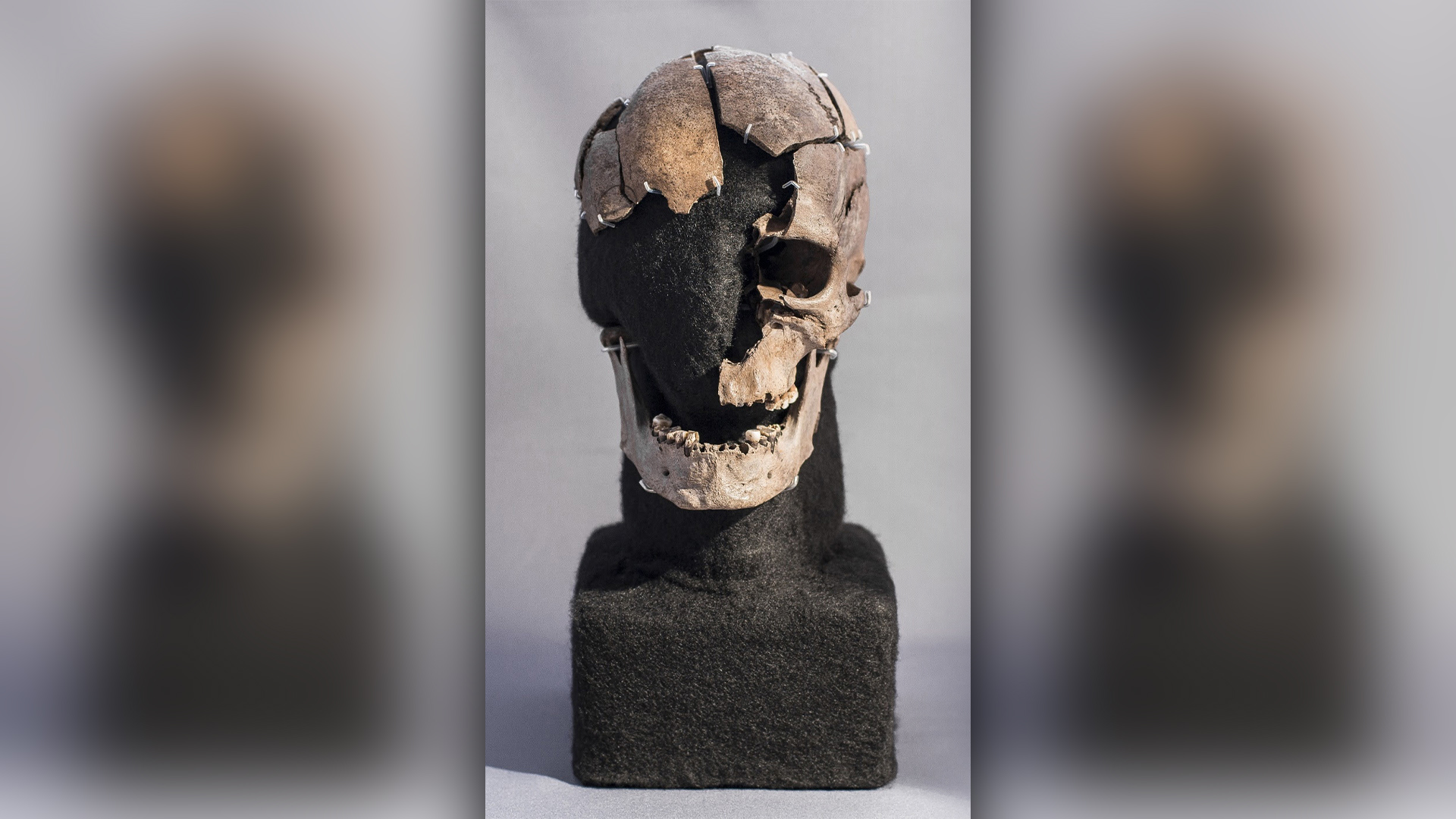Skull of Neolithic 'bog body' from Denmark was smashed by 8 heavy blows in violent murder
A new look at a 5,000-year-old bog body from Denmark suggests that the individual may have been an itinerant flint trader who was sacrificed by hostile locals.

The bones of a Neolithic man found over a century ago in a Danish peat bog reveal that he was an immigrant who was brutally murdered. To solve the 5,000-year-old cold case, researchers studied everything from dental plaque to DNA. They concluded that this "Vittrup Man," as researchers call him, may have been an itinerant flint trader who was sacrificed by hostile locals.
In 1915, peat diggers discovered a handful of human and bovine bones at the bottom of their trench near the village of Vittrup in northern Denmark. After finding a ceramic pot and a wooden club, the diggers contacted the local history museum about the artifacts. While these two objects, dated to around 3800 to 3500 B.C., were soon taken to the National Museum of Denmark and displayed, the bones remained largely unstudied for a century.
Two recent studies of genomes of people who died in the Mesolithic to Neolithic periods of European prehistory, however, revealed that Vittrup Man lived between 3300 and 3100 B.C. and had a genetic profile distinct from those of his local contemporaries. The results of a full analysis of Vittrup Man, published Wednesday (Feb. 14) in the journal PLOS One, reveal a life history that included migration, dietary changes and an early death in a land far from his original home.
Related: Who were Europe's 'bog bodies'? Deep look uncovers the secrets of this mysterious practice.
Who was Vittrup Man?
A right ankle bone, a left lower shin, and a fragmented skull and jaw with 16 teeth are all that remain of Vittrup Man. The bones suggest he died at around 30 to 40 years old, the researchers wrote in their study.
Vittrup Man was born at a time when Northern Europe was largely populated by farming communities, according to the research team, led by Anders Fischer, an archaeologist in the Department of Historical Studies at the University of Gothenburg in Sweden. But the team's analysis of dietary proteins trapped in his dental plaque and of elemental variations in his bones and teeth suggested he was probably from a fisher-hunter group from the northern Scandinavian coast, near the Arctic Circle.
Plaque forms on all humans' teeth, but when it is not brushed or picked away, it hardens into dental calculus that is rich in DNA and proteins that can preserve dietary information for thousands of years. Vittrup Man's calculus revealed that he consumed fish like cod and sea bream, as well as whale meat, dolphin meat and mutton.
Get the world’s most fascinating discoveries delivered straight to your inbox.
By the time Vittrup Man was a teenager, though, his diet included more terrestrial and freshwater food sources, according to an analysis of the carbon isotopes in his teeth. Analyzing isotopes — variants of an element — from different bone and dental tissues can clue researchers in to changes that happened over a person's lifetime.
Vittrup Man's dietary changes coincided with a geographical shift. A comparison of the strontium and oxygen isotopes in one of his bicuspids with those in one of his wisdom teeth showed that he moved sometime before age 12, likely to a farming community.
Why Vittrup Man moved is unclear, but Fischer and colleagues suggested that he may have been searching for flint axes and agricultural products in return for commodities he brought from his native land. An alternative theory is that he could have been captured, and perhaps enslaved, by a hostile group.
Either way, Vittrup Man met an unfortunate end. "The fragmented state of the cranium is the result of at least eight blows," the researchers wrote in their study, "which split it into several parts. There are no signs of healing — the traumas were obviously fatal."
The oval-shaped fractures on his skull point to blunt force inflicted with a hard object with a rounded surface, perhaps similar to the maple-wood club found in the peat bog. That finding led the researchers to speculate that Vittrup Man "could be a victim of feud or murder," but they noted that previous archaeological findings "make it more probable that he was sacrificed."
"The site appears to have been used now and then during the Neolithic for sacrificial activity," Fischer told Live Science in an email, but "no specific deity is known for that period and region." Rather, it is likely that people were asking an unknown spirit or deity for goodwill through the sacrifice of valuables, such as cattle and humans, Fischer said.
Alexis Boutin, a bioarchaeologist at Sonoma State University in California who was not involved in the study, told Live Science by email that "the authors draw on a wide array of evidence to show how Vittrup Man embodied the transition between Mesolithic (foraging) and Neolithic (farming) ways of life, while also shedding unique light on practices of hunting, regional migration and exchange, and ritualized sacrifice."

Kristina Killgrove is a staff writer at Live Science with a focus on archaeology and paleoanthropology news. Her articles have also appeared in venues such as Forbes, Smithsonian, and Mental Floss. Kristina holds a Ph.D. in biological anthropology and an M.A. in classical archaeology from the University of North Carolina, as well as a B.A. in Latin from the University of Virginia, and she was formerly a university professor and researcher. She has received awards from the Society for American Archaeology and the American Anthropological Association for her science writing.




